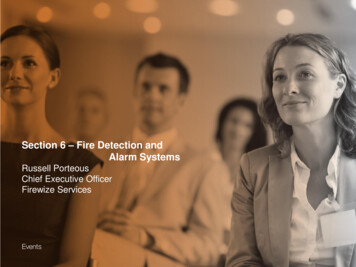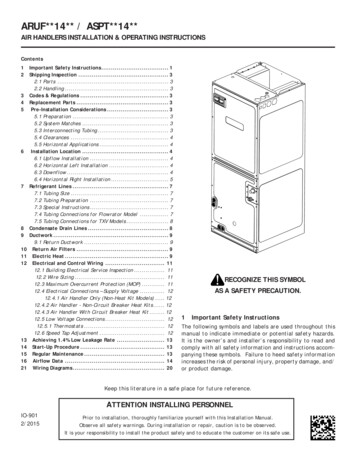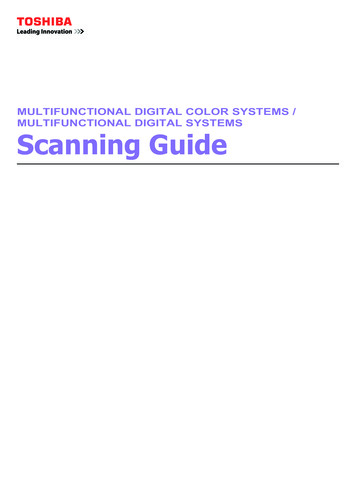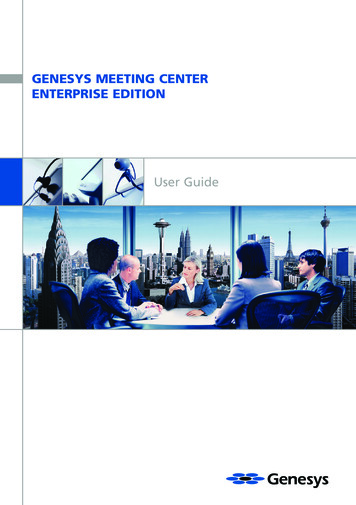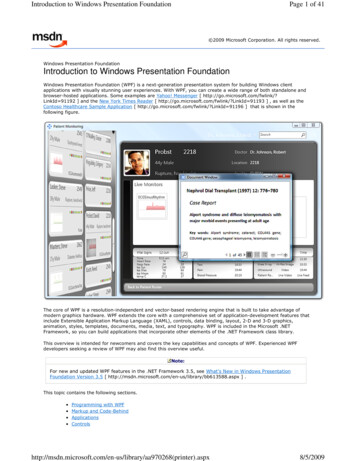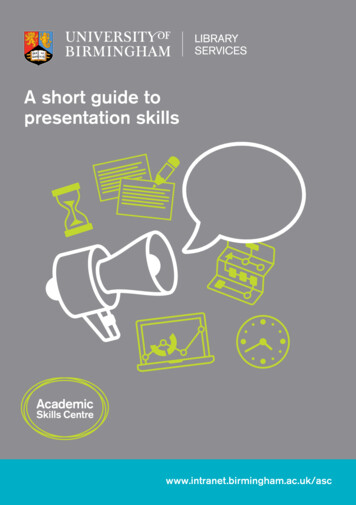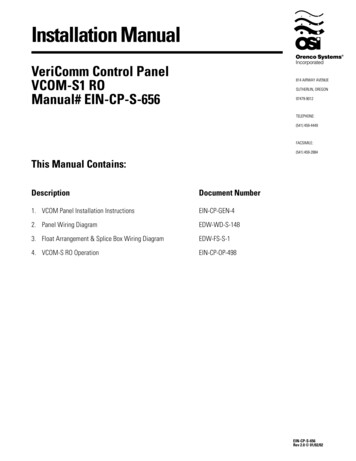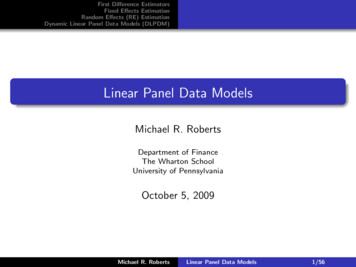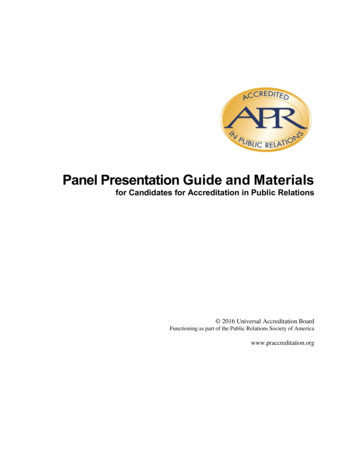
Transcription
Panel Presentation Guide and Materialsfor Candidates for Accreditation in Public Relations 2016 Universal Accreditation BoardFunctioning as part of the Public Relations Society of Americawww.praccreditation.org
Table of ContentsWelcome to the Panel Presentation . 1Panel Presentation at-a-Glance . 2I. Purpose of the Panel Presentation . 3II. Panel Presentation Procedures . 4For the Candidate . 4About the Panelists . 4How Does Panel Presentation Work? . 4III. Panel Presentation Questionnaire . 6How to Submit . 6When to Submit . 6Completing the Questionnaire . 6IV. Preparing for the Panel Presentation . 7The Portfolio . 7The Presentation . 8V. Appendices . 9Appendix A.Appendix B.Appendix C.Appendix D.Twelve Areas of Competency Assessed by the Panel Presentation . 10Resources for the Preparation for Examination for Accreditation in Public Relations . 11Panel Presentation Questionnaire . 13Detailed List of Knowledge, Skills and Abilities Assessed in Computer-BasedExamination . 15
Panel Presentation Guide and Materials for CandidatesWelcome to the Panel PresentationThe Panel Presentation the first of two steps to achieve Accreditation. This document is divided into five sections:I. Purpose of Panel Presentation. The Panel Presentation evaluates a candidate’s knowledge, skills andabilities in 12 specific areas that cannot be effectively judged in the computer-based Examination.II. Procedures for Panel Presentation. This section offers policies, procedures and how-to’s for the PanelPresentation and its two components: 1) the completion of a Panel Presentation Questionnaire and 2) the PanelPresentation itself.III. Panel Presentation Questionnaire. In this section, candidates will find tips on preparing responses to mosteffectively demonstrate public relations expertise.IV. Preparing for Panel Presentation. Information in this section will help the candidate learn how theportfolio, public relations plan and responses required in the Panel Presentation Questionnaire come togetherfor the Panel Presentation.V. Appendices. This section contains resources needed to prepare for the Panel Presentation, including theQuestionnaire and lists of knowledge, skills and abilities assessed in the Examination for Accreditation inPublic Relations. For additional resources, visit the Universal Accreditation Board website atwww.praccreditation.org.1
Panel Presentation at-a-GlanceTypical Timeframe*CandidateBefore Panel PresentationNotify local Accreditation chair of intent toenter Accreditation process.Chair/PanelistsProvide candidate with local resources andoverview on process.Read this document thoroughly and assessyour public relations experience and ability torespond effectively to the Panel PresentationQuestionnaire before completing theapplication.Before ApplicationSubmittalBegin collecting and preparing materials forPanel Presentation.Month 1Submit application for Accreditation toUniversal Accreditation Board.14 days after application isreceived by UAB.Receive notification from UAB of applicationapproval. If not approved, UAB providesreasons for ineligibility.Receive notification from UAB of candidate'sapplication approval.Note: Panel Presentation and computer-basedExamination MUST be completed within oneyear of application approval.Months 1, 2, 3Prepare for Panel Presentation and computerbased Examination.Conduct study groups, assist candidate inpreparation.Recruit three Accredited professionals toserve as panelists in the Panel Presentation.Month 1 (30 days prior toPanel Presentation)Request schedule for Panel Presentation.Prepare written responses to PanelPresentation Questionnaire, portfolio andpresentation.Organize panelists; identify date, time andlocation.Month 2 (15 days prior toPanel Presentation)Submit Panel Presentation Questionnaire.Review candidates written responses to PanelPresentation Questionnaire.Month 2Month 2, 3Immediately followingPanel PresentationFinalize portfolio and presentation.Participate in Panel Presentation.Within five business daysfollowing PanelPresentationWithin two weeks of receiptof panel's recommendationPost Panel PresentationConduct Panel Presentation.Vote for Advance or Not Advancerecommendation.Submit required documentation andrecommendation to UAB.Receive notification via regular mail ofAdvance or Not Advance status from UAB.Receive notification via email of Advance orNot Advance status from UAB.If Advanced, prepare for computer-basedExamination. Must sit for Examination bycompletion deadline (one year afterapplication approval.)Provide mentoring and preparation support tocandidate, as needed.If not Advanced, may repeat PanelPresentation process after 90-day waitingperiod. Must sit for Examination bycompletion deadline (one year afterapplication approval.)*Each candidate progresses through this process at his or her own pace.This timeframe reflects an average time period but may be shortened or lengthened per candidate’s needs.2
I. PURPOSE OF PANEL PRESENTATIONThe Panel Presentation is the first in a two-step process to earn Accreditation in Public Relations. It is a gateway tothe computer-based Examination.According to the Universal Accreditation Board Policies and Procedures, the intent and purpose ofthe Panel Presentation is to assess the candidate’s performance on the KSAs that cannot beassessed on the computer-based portion of the Examination.“The intended result of the Panel Presentation is that each candidate will earn an Advance or NotAdvance assessment that will recommend the Universal Accreditation Board (UAB) either acceptor decline the candidate’s request for admission to the computer-based Examination at this time.”**The final decision on whether or not to advance a candidate rests with the Universal Accreditation Board.The Panel Presentation is an opportunity for the candidate to demonstrate competence in 12 specific areas of publicrelations knowledge, skills and abilities that cannot be effectively judged in the computer-based Examination:1.2.3.4.5.6.7.8.9.10.11.12.Creative l skillsManagement skillsMulti-taskingFlexibilityTime managementUses multiple delivery mechanismsCommunication skills/SpeakingCommunication skills/Writing and EditingCommunication skills/ListeningPresentation skillsTip 1The complete list ofknowledge, skills andabilities tested can befound in Appendix A andAppendix D.Details for each of these areas can be found in Appendix A.3
II. Procedures for Panel PresentationThe Panel Presentation has two components: The Panel Presentation Questionnaire and the presentation itself.Detailed instructions for both appear in Section III and IV. This section provides information about how the PanelPresentation process works.For the CandidatePotential candidates first submit an application to the Universal Accreditation Board (UAB) that confirms work inpublic relations and the required minimum qualifications for Accreditation. See the Examination for Accreditation inPublic Relations Application. Candidates have one calendar year from the date the application is approved to completethe Panel Presentation and computer-based Examination. The Panel Presentation may be taken as many times asnecessary during that calendar year to advance to the computer-based Examination.Once the application is approved, candidates contact the local Accreditation chair to plan for the Panel Presentationand to learn about study courses and sessions.Timing and location for the Panel Presentation. The Panel Presentation will take place during atime and place mutually agreed upon between candidate and Accreditation chair. Panel Presentations mayalso occur at annual meetings or conferences, or at the end of intensive preparation sessions such as BootCamps.Location. The Accreditation chair arranges the meeting location, typically a professional setting (e.g.,conference room of local agency/organization), free of distractions (phones, etc.).The candidate completes and submits the Panel Presentation Questionnaire no fewer than 15 days prior tothe Panel Presentation.About the PanelistsThe Panel Presentation process employs a volunteer panel to assess the candidate’scompetence in 12 areas of skills as noted in Appendix A. The panelists recommendto UAB an Advance or Not Advance recommendation of the candidate.How Does the Panel Presentation Work?Step 1. The Panel Presentation QuestionnaireThe Panel Presentation Questionnaire is a two-part survey where candidates respondto questions in these areas:1) organization and role;2) work experience and sample public relations plan;Tip 2Within your responsesto the Questionnaire,you will provide acomplete publicrelations plan.Candidates, on average, spend eight to 10 hours to complete the Panel PresentationQuestionnaire. The Questionnaire should represent the candidate’s best public relations writing and should beproofread thoroughly.The completed Questionnaire is submitted to the local Accreditation chair at least 15 business days before thePanel Presentation (Step 2). Panelists study the candidate’s responses carefully and prepare a list of questions orconcerns to review with the candidate during the Panel Presentation.Step 2. The Panel PresentationBefore the Panel Presentation, the candidate prepares a portfolio of materials demonstrating a public relations planand other public relations activities. The portfolio is NOT submitted before the Panel Presentation; the candidatebrings the portfolio on the day of the presentation.4
During the Panel Presentation, three panelists meet with the candidate to:Listen to the candidate’s presentation of the portfolio materials supporting the public relations plan outlined inthe Questionnaire.Ask questions about the candidate’s written responses to the Panel Presentation Questionnaire.Step 3. Scoring the Panel PresentationUsing a scale of “0” to “3,” each panelist completes a voting form rankingeach of the 12 areas of competence:0 the candidate was unable to demonstrate any knowledge, skills orabilities in the rated areas;1 the candidate demonstrates a very weak level of knowledge, skills andabilities in the rated area;2 the candidate shows acceptable knowledge, skills and abilities in therated area;3 the candidate demonstrates exceptional knowledge, skills and abilities inthe rated area.Tip 3Candidates mustreceive a score of“1” or better in eachof the 12 KSAs.If the candidate achieves a total of at least 24 points and has no zero assessments in any single KSAcategory from any panelist will receive an Advance recommendation.If a candidate does not achieve a total of at least 24 points, or has a zero assessment in any single KSAcategory from any panelist, the candidate will receive a tentative Not Advance recommendation.Panelist(s) scoring the candidate as Not Advance must complete a document that describes reasons for aNot Advance recommendation and submit(s) the document to the panel chair.Within five business days, the panel chair sends an Advance/ Not Advance recommendation, along with othermaterial, to the UAB. The candidate is notified by mail about an Advance or Not Advance status within two weeksof receipt of these materials.Appeal ProcessAfter two separate unsuccessful Panel Presentation sessions, candidates may make a formal appeal in writingto UAB chair. The chair will appoint a member of the UAB Eligibility and Appeals Work Group, will investigatethe appeal and make a recommendation to the UAB chair and Executive Committee. The final ruling will be madeas determined by the UAB Chair.A candidate who receives a Not Advance status and whose organization cannot accommodate a secondPanel Presentation within the one-year time frame may apply to UAB for an extension.5
III. THE PANEL PRESENTATION QUESTIONNAIRECandidates should contact the local Accreditation chair at least one month before a proposed Panel Presentation.How to SubmitAs directed by the Accreditation chair, candidates will submit four printed copies of the completed Questionnaireor will send the Questionnaire via e–mail to an address provided by the Accreditation chair.When to SubmitThe completed Panel Presentation Questionnaire must be submitted no fewer than 15 business days prior to yourscheduled Panel Presentation.Completing the QuestionnaireThe Panel Presentation Questionnaire can be found online at www.praccreditation.org or in Appendix C. In additionto completing the Questionnaire, the candidate also compiles a portfolio of materials that were prepared in theexecution of the public relations plan described in the Questionnaire. The portfolio is not submitted beforehand butis presented by the candidate during the Panel Presentation.NOTE: Proofread your submission carefully. It should be free of typographical and formatting errors.Section One: Your Organization and Your RoleIn this section, candidates provide information about current employment in public relations. There is no word orpage limit but responses should be succinct. Responses to each question should reflect your work situation.Section Two: Your ExperienceThis is the heart of the Panel Presentation. Candidates present a public relations plan that they have planned andimplemented using the Research, Planning, Implementation and Evaluation (RPIE) four-step process. Materialsproduced in the execution of the plan are included (collaterals, scripts, messaging, news releases). These items willbe the core of the portfolio. Using the RPIE process in your Questionnaire is a good way to become even morecomfortable and familiar with this planning process — it accounts for 30 percent of the computer-basedExamination.If a candidate contributed but was not solely responsible for the creation of a four-step plan, he or she shoulddescribe how members of the public relations team developed and executed the plan. Discuss what best practiceswere used or could have been used to develop the plan into a full spectrum of public relations programming tomeet the goals and objectives of the plan. Candidates should clearly identify their role(s) with the plan and rolestaken by other members of the team.For examples of well-written sketches of comprehensive public relations plans, visit the PRSA Silver Anvil awardrecipients’ submittals at www.prsa.org/awards/index.html.6
IV. PREPARING FOR PANEL PRESENTATION After the PanelPresentation Questionnaire has been submitted, candidates have 15 days tofinalize the portfolio and presentation.The PortfolioThe portfolio should furnish the fullest possible evidence of use of publicrelations research, planning, implementation and evaluation.Presentation of a vast collection of tactical tools without demonstration ofsituation appraisal, program planning and evaluation will be inadequateevidence of mastery of the complete spectrum of the public relations practice— regardless of the quality and quantity of work products shown.Tip 4The portfolio containsmaterials illustratingthe public relationsplan you havedescribed in theQuestionnaire. It isnot submitted with theQuestionnaire; bringthe portfolio with youto the Presentation.Focus the portfolio materials on the public relations campaign described in the Panel Presentation Questionnaire.Additional materials from other public relations campaigns can be included if they help demonstrate public relationsstrengths. The portfolio materials should support all elements of the plan from the Panel Presentation Questionnaire,including the following: An initial statement of the problem or opportunity.Tip 5 Primary and/or secondary research to validate the problem or opportunity and translate it into a situation appraisal that drives one or more specific program objectives. Identification of goals, objectives, strategies and program elements/tactics directed to targeted audiences that will accomplish stated program objectives.Evaluation activities that were used to assess the program objectives and situation appraisal to demonstrateprogram effectiveness.Make sure you knowthe differencebetween primary andsecondary research.Many candidates prepare the portfolio in a three-ring binder, with tabs to reflect research, planning, implementationand evaluation products. A fifth tab for materials from other campaigns could complete the portfolio. The keypoint in the portfolio should be the demonstration of a single program, from inception to completion, with anemphasis on the full cycle of conceptualization, research, program development, implementation and assessment.We recommend compiling at least three copies of the portfolio so each panelist can follow along with thepresentation.The Accredited panel understands that candidates may not have been directly or solely involved with all aspects ofthe program presented. However, candidates should be prepared to describe activities conducted by other teammembers that contributed to the creation of the complete program. If candidates have no knowledge of certainaspects of the program, they should be equally prepared to provide a clear statement of the best practices that wouldbe appropriate to create a full continuum of programming.If candidates have not held a professional position in which creation, development, implementation and assessmentof one or more campaigns were within the realm of assigned duties, candidates may want to volunteer for anonprofit organization to provide pro-bono services and thus, create a source of materials for the portfolio. LocalAccreditation chairs also may be able to offer suggestions for rounding out the portfolio presentation.7
The PresentationTime LimitPresentations should be a minimum of one hour, with a maximum of two hours, including time for panelists’questions. Count on between 30 and 60 minutes to present the portfolio; the remaining time will be used by thepanelists for questions about the written responses to the Panel Presentation Questionnaire.Organizing the Panel PresentationThe goal is to relate a professional story to the panelists told through the selected public relations plan and perhaps afew other portfolio items. Like a case study, the best approach to organizing the presentation is to start at thebeginning of the process and take the panelists through the program.Pay Attention to the DetailsMake sure that all materials in the portfolio are in good order, that these elements adequately and accuratelyrepresent the quality of work and that they provide a clear indication of the role the candidate played in the creationof each item. Candidates should be able to provide the rationale and facts behind creation of each element or tacticpresented and to respond to any questions that the panelists may ask. The focus should always be on the connectionbetween the elements being presented, the objectives and the outcomes of the program. Carefully proofread allmaterials.Keep the Panel Presentation ManageableCandidates are solely responsible for securing and operating any equipment neededfor the presentation, and there is limited time to set up equipment. ThereforePowerPoints, audio and video clips or flipcharts are not recommended. Part of thescoring for the presentation is based on speaking and presentation ability, not theability to present a slide show (minimum of one hour, maximum of two hours).Tip 6Candidates are solelyresponsible for settingup a n y LCD or othertypes of computerprojectors for thePanel Presentation.After the Panel PresentationOnce the panel has completed its review of the Presentation and Questionnaire, their recommendation to Advance orNot Advance the candidate through Panel Presentation will be forwarded to the Universal Accreditation Board. TheUAB will notify candidates of the results.Neither panel members nor local Accreditation volunteers can provide information on the outcome of the presentation.If the Panel Presentation process reveals one or more areas in which a candidate needs additional work beforebeing Advanced to the computer-based Examination, feedback from the panelists will be available upon request tothe local Accreditation chair.Questions?For more information on the Panel Presentation or about Accreditation in Public Relations, please visit the UniversalAccreditation Board at www.praccreditation.org. Or, contact the Universal Accreditation Board administrator:Kathy Mulvihill; Public Relations Society of America; 120 Wall Street, 21st Floor; New York, NY 10005 Phone:(212) 460-1400; accred@prsa.org.8
V. AppendicesAppendix A.Appendix B.Appendix C.Appendix D.Twelve Areas of Competency Assessed by the Panel PresentationResources for the Preparation for Examination for Accreditation in Public RelationsPanel Presentation QuestionnaireDetailed List of Knowledge, Skills and Abilities Assessed in Computer-basedExamination9
Appendix A: Panel PresentationThe Panel Presentation panel will be responsible for evaluating candidates’ readiness in 12 specific areas ofcompetence that cannot effectively be judged in the computer-based Examination environment:1.Creative conceptualization/creativity: Uses imagination to develop new insights into or responses toa public relations issue. Develops innovative solutions to the issue or problems posed. Devises newmethods/processes or adapts existing ones when the standard methods and processes are not applicable.2.Initiative: Displays courage in suggesting new ideas and justifying them to clients/employers.3.Interpersonal skills: Relates empathetically to other individuals in order to understand their concerns orneeds. Influences another’s decision or behavior. Displays confidence when interacting with others.4.Management skills: Develops expertise in planning, organizing, budgeting, communicating,coordinating, scheduling, monitoring and evaluating.5.Multi-tasking: Effectively and efficiently manages numerous projects and responsibilities simultaneously.Applies prioritization and tracks progress toward completion of tasks.6.Flexibility: Responds to the changing business, social and cultural landscape.7.Time management: Prioritizes and sequences tasks to meet goals and deadlines.8.Uses multiple delivery mechanisms: Uses advertising, direct mail, Web and other deliverymechanisms and promotional tools effectively.9.Communication skills/Speaking: Demonstrates logical thinking when describing client issues andframing approaches to solving public relations problems.10. Communication skills/Writing and Editing: Communicates relevant information (including technicalmaterial) in a concise, organized fashion. Writes content that is factual and grammatically accurate, and at areading level that is appropriate to the target audience. Authors persuasive communication material forpublic relations programs. Demonstrates the ability to examine and alter a document and correct for format,organization, completeness, factual accuracy, style, tone and grammar.11. Communication skills/Listening: Receives, interprets, verifies, and responds to verbal and non-verbalmessages and other cues in the context of client, teammate and audience concerns.12. Presentation skills: Uses visual aids (charts, slides, transparencies, etc.) effectively. Maintains eyecontact with audience. Uses appropriate language, gestures, tone of voice and volume to conveyinformation.10
Appendix B: Resources for the Preparation for Examination for Accreditation inPublic RelationsThe Accreditation in Public Relations Online Study CourseOne-year subscription: 195 for members of UAB Participating Organizations 295 for non-membersThis interactive online multimedia course helps candidates prepare for the Examination for Accreditation in PublicRelations (APR). Course content, geared toward the knowledge, skills and abilities measured during the Examination, ispresented through a variety of interactive methods, including multimedia module introductions, asynchronous activities,case study analysis, projects, directed discussions, self-correcting quizzes and simulations. It provides opportunities forself-study, collaboration and teamwork, all situations that public relations professionals encounter in their day-to-daywork.The course is easy to use. Candidates can proceed through the course at their own pace, and optional web conferencesallow candidates to ask questions and meet other course participants. This Online Study Course is helpful to those whocan't participate in the study programs offered by local Chapters and member organizations because of distance or otherconstraints. It also is valuable to candidates who want to take advantage of additional preparation tools for theExamination for Accreditation in Public RelationsAPR Study GuideThe APR Study Guide is a key tool in preparation for Accreditation in Public Relations and a tremendous resource for allAPR candidates. It contains exercises, case studies and insight into modern public relations practices. And, it’s availableat no cost to those pursuing Accreditation.The Short Bookshelf of Texts Recommended to Candidates for Accreditation in Public RelationsThe Universal Accreditation Board suggests that APR candidates review contents of at least one general text and at leastone of the specialized texts from the bookshelf of texts. You do NOT need to buy or study every text on the ShortBookshelf.Short Bookshelf of Recommended Texts·AP Stylebook current editionThe Associated Press Stylebook and Briefing on Media Law (current edition). New York: The AssociatedPress.·EPR 11th edition or currentBroom, G. M., & Sha, B-L (2013). Cutlip and Center’s Effective Public Relations (11th or current edition).Upper Saddle River, N.J.: Pearson Education.·Primer of PRStacks, D. W. (2002). Primer of Public Relations Research. New York: Guilford Press.·Strategies and Tactics 11th edition or currentWilcox, D. L., Cameron, G. T., & Reber, B. H. (2015). Public Relations: Strategies and Tactics (11th orcurrent edition). Upper Saddle River, N.J.: Pearson Education.·Strategic Planning 3rd or currentSmith, R. D. (2009). Strategic Planning for Public Relations (3rd or current edition). Mahwah, N.J.:Lawrence Erlbaum.For the entire bookshelf of texts recommended to candidates for Accreditation in Public Relations, mmended-texts/index.html.11
Appendix C: Panel Presentation Questionnaire for CandidatesINSTRUCTIONSYou will submit either an electronic copy or 3 copies of your typewritten responses to the PanelPresentation Questionnaire no fewer than 15 business days before your scheduled PanelPresentation. Submit your completed document to your local or organizational Accreditation chair.SECTION ONE: YOUR ORGANIZATION AND YOUR ROLEThis section asks for your response to questions about your current employment in public relations,be it corporate, non-profit, agency or academic. Answer all questions completely and succinctly.Answers in this section are not right or wrong. They should be truthful and accurate.1) Why have you chosen to become Accredited at this time?2) Describe how your public relations agency, department or other operation is organized. Describe thereporting structure, personnel and the key relevant roles of each person.3) Given the current economic climate and present social situations, what is/are the majorproblem(s)/opportunity(-ies) facing your department, agency or other public relations operation at thistime? What about in the next three-to-five years? Pick and briefly articulate the most significantsolution or approach you would recommend to address this opportunity or challenge.4) Describe the changes, if any, you think are needed in the structure/function of your public relationsagency, department or operation. Describe the steps you would recommend to implement thesechanges.5) If you were starting a public relations department, academic department or public relations agencytoday (or starting over again in your organization, institution or agency), what would be your top-threeconcerns or considerations in doing so, a
Before the Panel Presentation, the candidate prepares a portfolio of materials demonstrating a public relations plan and other public relations activities. The portfolio is NOT submitted before the Panel Presentation; the candidate brings the portfolio on the day of the presentation. Tip 2 Within your responses to the Questionnaire, you will .
